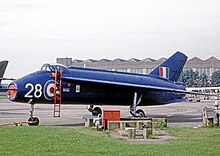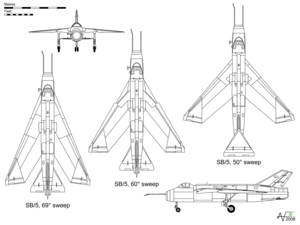Short SB.5
| Short SB.5 | |
|---|---|
 Short SB.5 |
|
| Type: | Experimental airplane |
| Design country: | |
| Manufacturer: | |
| First flight: |
2nd December 1952 |
| Number of pieces: |
1 |
The Short SB.5 was an experimental aircraft produced by the British manufacturer Short Brothers . It was created on the basis of the Air Ministry's tender ER.100 in order to gain new insights into the slow flight characteristics of the planned English Electric Lightning supersonic fighter by using different wing sweep angles . The only model built had the RAF serial number WG768.
construction and development
A technical dispute between the Royal Aircraft Establishment and the English Electric Company (EWG) over the optimal configuration for the planned supersonic fighter formed the basis for the construction of the Short SB.5. A single-seat research machine with a mid-fuselage wing was built to investigate the possible configurations in the low speed range. The same basic configuration of the P.1 was installed in a simpler airframe with a rigid landing gear. Since the SB.5 was intended for low-speed testing, there was no requirement for a retractable landing gear.
The contract was awarded on August 2, 1950 to the Short Brothers and Harland Ltd of Belfast. The machine was designed to test three different wing sweep angles (50 °, 60 ° and 69 °). The conversion of the wings to a different sweep angle and the change of the tail unit configuration had to be done in the manufacturing plant. Two different tail positions, (a) low on the rear fuselage and (b) on top of the vertical tail, were tested. For this purpose, two completely different rear fuselage parts with tail units were built. The complete rear fuselage, directly after the engine, was removable and two alternative rear fuselage parts were available, one with the horizontal stabilizer on the vertical stabilizer and the other with the horizontal stabilizer under the fuselage. The setting angle of the tailplane fin was electrically adjustable during flight.
The wings had a light metal box spar, on which stringers were riveted over the span . The planking was also made of light metal. Only the leading and trailing edges of the wing were made of plywood, as these had to be rebuilt each time the wing was converted. Two braking parachutes with a circumference of 6.1 m and a 6.1 m anti-spin parachute were located in the rear fuselage above the jet pipe.
Before the Short SB.5 there was no practical experience with wings of this sweep. The SB.5 was developed to test this configuration in a step-by-step procedure, initially with a 50 ° arrow before converting to 60 °. To increase its usefulness as a research aircraft, it was able to fly with a 69 ° wing sweep.
history
Flight tests were carried out with an increasing degree of sweep and with the horizontal stabilizer in two possible positions:
The first flight at 50 ° was made from Boscombe Down by Shorts Chief Test Pilot Tom Brooke-Smith on December 2, 1952. In 1953, at the Society of British Aircraft Constructors Air Display in Farnborough, he gave an impressive demonstration of the SB.5's maneuverability and speed.
In July 1953, the first test flights were carried out with the wing with a mean sweep of 60 ° and with a T-tail unit. Tests with the lower horizontal tail position began in January 1954, so that their evaluation was available before the P.1's first flight. It was finally determined that the T-tail configuration was unsatisfactory. Tests with the 60 ° bearing were completed in April 1958.
Before testing the final wing swept configuration with 69 °, a Martin-Baker ejection seat was installed for the first time and the Rolls-Royce Derwent was replaced by a Bristol Orpheus with greater thrust. The first flight was made by Denis Tayler on October 18, 1960 on the RAE Bedford. This was the highest degree of wing sweep in the world at the time.
The experience gained with the SB.5 with regard to wing sweep and tailplane configuration flowed into the practical testing of the P.1, the English Electric Lightning . After more than eleven months, the tests with 50 ° and 60 ° sweep and T-tail were completed. In January 1954, the stern with the low-lying horizontal stabilizer was installed and tested for a further two years. This proved that the EEC configuration was correct. After completing its test programs, the SB.5 came to the Empire Test Pilots' School (ETPS) in Farnborough in 1967 , as evidenced by the ETPS 25th Anniversary Brochure 1968. The Empire Test Pilots' School flew the machine to give pilots experience in flight testing of "slim" aircraft.
The SB.5 is on display at the Royal Air Force Museum , Cosford, Shropshire (with its two stern sections).
Technical specifications
Configuration from 1952 with 55 ° arrowhead and T-tail
| Parameter | Data |
|---|---|
| crew | 1 |
| length | 13.94 m |
| span | 10.9 m |
| height | 5.28 m |
| Wing area | 30.66 m² (330 ft²) |
| profile | symmetrical |
| Wing extension | |
| Empty mass | 4173 kg |
| Takeoff mass | 5443 kg |
| Tank capacity | 1364 l (300 gal.) |
| Top speed | 649 km / h |
| Service ceiling | |
| Range | |
| Engines | 1 × Rolls-Royce Derwent Mk. 8 Turbojet, 16 kN (3600 lbf) |
See also
literature
- "Empire Test Pilots' School: Twenty Five Years" . Empire Test Pilots' School Twenty-fifth Anniversary brochure. 1968.
- "Sweepback-60 °" . Shorts Quarterly Review, Vol. 2, No. 3rd Autumn 1953.
- KJ Staples: "Tests on the Short SB5 with 60 ° and Low Tailplane - Part I - Forces and Moments" . London: Office of Public Sector Information HMSO , 1969.
- Jim Winchester: X-Planes and Prototypes . London: Amber Books Ltd., 2005. ISBN 1-904687-40-7 .
- Barry Jones: Short's three degrees - British post-war experimental jets, Part 10 . In: Airplane Monthly November 1993
Web links
- British Aircraft Directory
- RAF Museum website
- “Integral Construction” a 1953 Flight article about the SB.5

